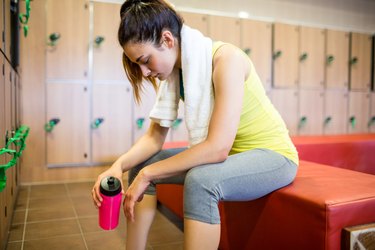
After an intense workout session, you may be used to experiencing things like muscle cramps or a runny nose. However, you may be surprised to discover some spotting in your underwear or workout pants.
Below, we'll explain what spotting is, why it may be happening and when it's time to see a doctor.
Video of the Day
Video of the Day
What Is Vaginal Spotting?
Spotting refers to any vaginal bleeding you may experience in between your normal monthly menstrual period, according to Mount Sinai Health System. What does spotting look like? It's common for vaginal bleeding to be any shade of pink, red or brown, per the Cleveland Clinic. Also, the blood you see typically isn't as heavy as your regular period.
Aside from exercise (which we'll talk more about below), there are many factors that can cause spotting, according to the Cleveland Clinic:
- Pregnancy
- Birth control
- Cervical infection
- Cervical polyp
- Cervical cancer
- Endometrial cancer
- Sexually transmitted infection (STI)
- Menopause
What Causes Spotting After Exercise?
1. Vaginal Irritation
The skin around your vagina is very sensitive, per the Cleveland Clinic. So, if you use any scented soaps, wipes, lotions or any other products to stop block odor after your workout, this could cause irritation that can lead to bleeding.
Also, the combination of certain clothing and your chosen activity could create friction, which can be a potential cause of vaginal bleeding. When choosing your underwear or workout pants, it's best to go for moisture-wicking fabrics that won't chafe, like spandex, nylon, wool, polyester, bamboo, rayon or latex, per the International Sports Sciences Association (ISSA).
2. Hormonal Imbalance
Too much strenuous exercise and not enough recovery in between workout sessions can decrease your amount of estrogen, progesterone and testosterone hormones and increase your amount of the stress hormone cortisol (more on how stress affects spotting below), per Rupa Health. This can make you susceptible to irregular periods and abnormal bleeding.
3. Stress
Putting your body under a lot of stress — like over-exercising, restricting your calories or a combo of the two — can cause cause an irregular period per the Cleveland Clinic, which can include spotting (or even the loss of your period altogether).
Too much stress can mess with your hormones and menstrual cycle because when your body is in a constant state of duress, "it only wants to use resources for things that are very, very, very important, like breathing and digesting," according to the Cleveland Clinic.
When to See a Doctor About Spotting After Exercise
While spotting isn't always an indication something's wrong, it's always best to make an appointment with your doctor to confirm the reason for it. You and your doctor can work together to better understand what's causing your spotting, how to treat it and if additional medical attention may be needed.
Additionally, if you're experiencing symptoms like lower abdomen pain after exercise or blood in your urine after exercise that isn't your period (called exercise-induced hematuria), it's important to seek medical attention right away. These may be signs of a more serious condition.
If you can't afford medical care, you can find low-cost options in your community through HealthCare.gov.
Prevention and Treatment for Spotting After Exercise
In order to prevent vaginal bleeding after exercise, it's important to take into consideration the types of clothing you're wearing, the intensity and duration in which you're exercising and how much recovery and fuel you're getting.
The treatment for spotting after exercise depends on the underlying cause, so it's important to talk to your doctor to narrow it down and come up with a plan going forward.
- Mount Sinai Health System: "Vaginal bleeding between periods"
- Cleveland Clinic: "Vaginal Discharge Color: What’s Normal and What Isn’t"
- ISSA: "Cotton vs. Synthetic: What's Best for Workout Gear?"
- Cleveland Clinic: "Yes, Weight Loss Can Impact Your Menstrual Cycle"
- Rupa Health: "How Different Exercises Affect Women's Hormones"